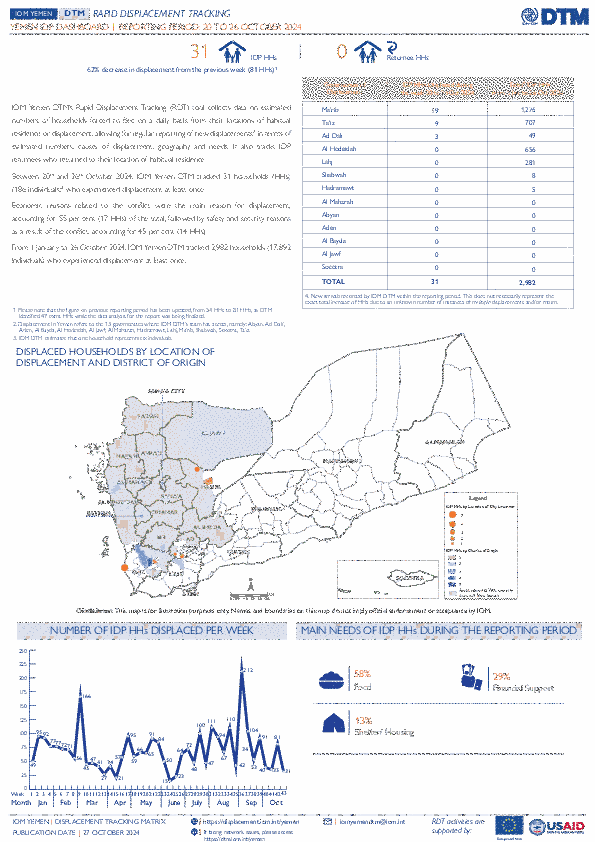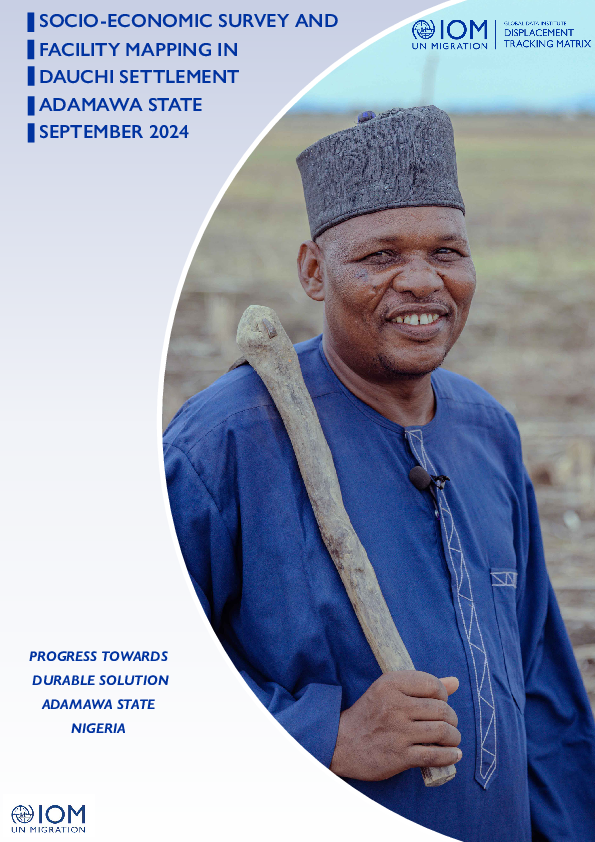-
Countries
-
Data and Analysis
-
Special Focus
-
Crisis Responses

Contact
dtmhaiti@iom.int
Language
English
Location
Haiti
Period Covered
Oct 11 2024
Oct 26 2024
Activity
- Mobility Tracking
- Event Tracking
This report is an update of the one that was published on 12 October (ETT 50) following armed violences in Arcahaie since 10th October, particularly in its 1st municipality section of Boucassin. A total of 21,770 people (5,384 households) have been displaced since the start of these violences, with 63% of them finding refuge with relatives in host families and 37% in 10 sites created following these violences. The majority of people left the 1st municipality section of Boucassin to seek refuge in other localities in the municipality of Arcahaie (92%), 7% went to Anse à Galets and the rest to Saint Marc.
Contact
DTM Yemen, iomyemendtm@iom.int
Location
Yemen
Activity
- Mobility Tracking
- Event Tracking
Period Covered
Oct 20 2024 -Oct 26 2024
From 1 January to 26 October 2024, IOM Yemen DTM tracked 2,982 households (HH) (17,892 Individuals) who experienced displacement at least once.
Between 20 and 26 October 2024, IOM Yemen DTM tracked 31 households (186 individuals) displaced at least once. The majority of people moved into/within the following governorates and districts:
- Ma’rib (19 HH) – Ma’rib (8 HHs), Ma’rib City (8 HHs), Raghwan (3 HHs) districts. Most displacements in the governorate originated from Al Hodeidah and Ibb.
- Ta’iz (9 HHs) – Al Makha (7 HHs), Al Misrakh (2 HHs) districts. All displacements in the governorate were internal.
- Ad Dali (3 HHs) – Al Azariq (3 HHs) district. Most displacements in the governorate originated from Lahj and Ta’iz.
The majority of people moved from the following governorates and districts:
- Ta’iz (12 HHs) – Jabal Habashi (4 HHs), Maqbanah (3 HHs), At Taiziyah (1 HH) districts.
- Al Hodeidah (5 HHs) – Az Zaydiah (2 HHs), Al Munirah (1 HH), As Sukhnah (1 HH) districts.
- Ibb (3 HHs) – As Saiyani (2 HHs), Hobeish (1 HH) districts.
Population Groups
IDPs
Returnee (Previously Internally Displaced)
Survey Methodology
Unit of Analysis Or Observation
Admin Area 2
Type of Survey or Assessment
Household
Key Informant
Keywords
Geographical Scope Partial Coverage
Administrative boundaries with available data
The current dataset covers the following administrative boundaries

Contact
DTM Yemen, iomyemendtm@iom.int
Language
English
Location
Yemen
Period Covered
Oct 20 2024
Oct 26 2024
Activity
- Mobility Tracking
- Event Tracking
IOM Yemen DTM's Rapid Displacement Tracking (RDT) tool collects data on estimated numbers of households forced to flee on a daily basis from their locations of origin or displacement, allowing for regular reporting of new displacements in terms of estimated numbers, geography, and needs. It also tracks returnees who returned to their location of origin.
From 1 January to 26 October 2024, IOM Yemen DTM tracked 2,982 households (HH) (17,892 Individuals) who experienced displacement at least once.
Between 20 and 26 October 2024, IOM Yemen DTM tracked 31 households (186 individuals) displaced at least once. The majority of people moved into/within the following governorates and districts:
- Ma'rib (19 HHs) – Ma'rib (8 HHs), Ma'rib City (8 HHs), Raghwan (3 HHs) districts. Most displacements in the governorate originated from Al Hodeidah and Ibb.
- Ta'iz (9 HHs) – Al Makha (7 HHs), Al Misrakh (2 HHs) districts. All displacements in the governorate were internal.
- Ad Dali (3 HHs) – Al Azariq (3 HHs) district. Most displacements in the governorate originated from Lahj and Ta'iz.
The majority of people moved from the following governorates and districts:
- Ta'iz (12 HHs) – Jabal Habashi (4 HHs), Maqbanah (3 HHs), At Taiziyah (1 HH) districts.
- Al Hodeidah (5 HHs) – Az Zaydiah (2 HHs), Al Munirah (1 HH), As Sukhnah (1 HH) districts.
- Ibb (3 HHs) – As Saiyani (2 HHs), Hobeish (1 HH) districts.
IOM identified 47 additional households displaced in the previous reporting period, which covered 13 - 19 October 2024, in the governorates of Ta'iz (26 HHs), Ma'rib (15 HHs), and Al Hodeidah (6 HHs). These figures have been added to the cumulative displacement total recorded since the beginning of the year.

Contact
DTM Nigeria, iomnigeriadtm@iom.int
Language
English
Location
Nigeria
Period Covered
Jul 01 2024
Sep 30 2024
Activity
- Survey
This report provides an in-depth look at the progress made in supporting the displaced residents of the Dauchi settlement, located in Song local government area, Adamawa State. Dauchi, home to over 200 households, has become a permanent refuge for people who were forced to flee their homes due to the insurgency in north-east Nigeria. Instead of returning to their areas of origin, many displaced persons have chosen to integrate into this local community.
Through a detailed survey, this report explores the living conditions and livelihoods of Dauchi’s residents while also assessing the availability of key infrastructure and services, such as health centres, schools, and water sources. In addition, demographic data from registration exercises offers valuable insights into the population’s age and gender distribution, which helps inform future interventions for the community.
The findings provide a comprehensive view of Dauchi’s socio-economic landscape and the challenges its residents face, making this report a vital resource for those working to improve conditions and provide long-term solutions for the settlement’s residents.

Contact
DTM Nigeria, iomnigeriadtm@iom.int
Language
English
Location
Nigeria
Period Covered
Oct 14 2024
Oct 20 2024
Activity
- Mobility Tracking
- Event Tracking
Between 14 and 20 October 2024, 56 new arrivals were recorded at locations in Benue State, including the Gwer West and Logo local government areas (LGAs).

Contact
DTM Nigeria, iomnigeriadtm@iom.int
Language
English
Location
Nigeria
Period Covered
May 22 2024
Jun 02 2024
Activity
- Survey
In recent years, climate and environmental changes have increasingly affected various regions across Nigeria, leading to significant disruptions in the lives of internally displaced persons (IDPs). This report presents an assessment conducted to evaluate the impact of these changes on IDP households living in camps across 10 states in two regions: north-central (Benue, Plateau, Nasarawa, Niger, and Kogi states) and north-west (Kaduna, Kano, Katsina, Sokoto, and Zamfara states). The assessment aimed to understand how climate and environmental events such as floods, sandstorms, windstorms, droughts, and erratic rainfall patterns have influenced the livelihoods, migration patterns, and resource access of IDP households.

Contact
DTM Nigeria, iomnigeriadtm@iom.int
Language
English
Location
Nigeria
Period Covered
Oct 07 2024
Oct 13 2024
Activity
- Mobility Tracking
- Event Tracking
Between 7 and 13 October 2024, 832 new arrivals were recorded at locations in Benue State, including the Guma, Gwer West and Logo local government areas (LGAs).

Contact
DTM Uganda, dtmuganda@iom.int
Language
English
Location
Uganda
Period Covered
May 28 2024
Jun 10 2024
Activity
- Flow Monitoring
The baseline assessment was conducted in 2 Districts (Kisoro & Isingiro) and 1 City (Mbarara City) in Southwestern sub-region of Uganda at the sub county level (19 sub-counties/Admin 2). The baseline assessment was crucial for identifying the numbers and locations of target populations (refugees, returnees & the host community) and understanding the impact of refugees on the host community.
The findings reveal that economic factors (32%), food scarcity (30%), and family reunification (13%) are the top three reasons for most refugees movements out of the settlement. Mbarara City hosts a larger proportion of refugees within the community (51%) compared to Isingiro, hosting Nakivale settlement (42%), and Kisoro, which contains the transit center (7%). Additionally, a higher percentage of departing refugees are male (57%), predominantly aged between 18 and 45.
Results showed that many refugees return to settlements mainly for family reunification (46%), with other reasons including economic factors (28%) and food shortages (23%). Refugees primarily find livelihoods in casual labor (78%), trade (75%), and farming (66%). Their presence has increased the labor supply (45%), provided economic benefits (28%), and improved access to social services (9%).
Contact
dtmlebanon@iom.int
Location
Lebanon
Activity
- Mobility Tracking
- Baseline Assessment
Period Covered
Oct 10 2023 -Oct 20 2024
Since October 8 there has been an increase in cross-border incidents between Israel and Lebanon, resulting in the displacement of people both within the South and elsewhere within the country. Since October 10, the Displacement Tracking Matrix (DTM) has been conducting the daily monitoring of population movements. The objective of the exercise is to inform preparedness and response planning.
To get access kindly click on the 'Request Access' button. Please use your official work email, specify the organisation name. Thank you.
Population Groups
IDPs
Survey Methodology
Unit of Analysis Or Observation
Admin Area 2
Admin Area 3
Household
Individual
Type of Survey or Assessment
Key Informant
Keywords
Geographical Scope Full Coverage
Administrative boundaries with available data
The current dataset covers the following administrative boundaries

